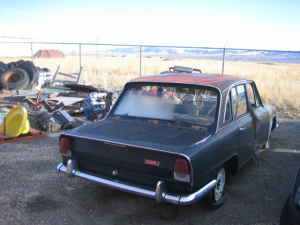If you look up Triumph on Wikipedia, the first sentence you will read is this: “The Triumph Motor Company is a defunct British motor manufacturer.” Sad. Established in 1885, Triumph graduated from selling bicycles to creating nimble little sports car and moderately competent sports sedans. However, by the bitter end in 1984, Triumph was reduced to selling the cheese-wedge TR7 (actually cancelled in 1981) and a rebadged Honda Civic known as the Acclaim. The company name is now owned by BMW, and Triumph has became just another punchline for the British car industry.
Speaking of pulling punches, welcome back to a long-overdue How Hard Can It Be?
The Triumph 2000 debuted in 1963 as the Mark I sedan and station wagon. It moseyed down the motor route by way of a 90-horsepower 2.0-litre straight-six spinning either a four-speed manual or a three-speed slushbox. Coil springs all around kept its attractively designed carcass off the pavement and power brakes, discs fore and drums aft, reined in all that oomph. Later cars received Lucas mechanical fuel injection replacing the dual Stromberg carburetors.
Second-generation 2000s, designed by Michelotti, debuted in 1970 and looked like four-door Stags, which is okay. The Mark I cars look like the later Dolomite Sprint, and that’s better.
 This particular Mark I 2000 is a sad example. The seller tells us basically nothing except that, despite needing a clutch slave “silinder,” this Triumph will still crack 225 kph. Of course it would, should you have a Lockheed C-130 from which to toss it.
This particular Mark I 2000 is a sad example. The seller tells us basically nothing except that, despite needing a clutch slave “silinder,” this Triumph will still crack 225 kph. Of course it would, should you have a Lockheed C-130 from which to toss it.
Further, the seller states this model has a Surrey Top. The pictures show no evidence to support this. A Surrey Top, usually found on two-seat roadsters, is a rigid rear top frame with a fixed window and a removable canvas center section over the front seats. Removing the canvas bit creates a targa top with a look made popular by the Porsche 911.
This 2000 may have the remnants of vinyl roof covering, a styling affectation used on everything from Rolls-Royces to Chevrolets. Or maybe it’s just rust where some paint used to be. It doesn’t matter because the best possible thing you can do to any 60s British sedan is hack in a retractable canvas Webasto-style sunroof. Surrey Top be damned!
Further summoning your proclivities with a Sawzall, this could be a neat runabout if you had US$2000 and a lot of free time. It might be tempting to cram a 3.0-litre Stag V8 under the hood, but those Stag engines are basically junk. Better to shoehorn a Rover 3.5-litre V8 or a even a turbocharged 3.8-litre Buick V6 plucked from an 80s Grand National. We’re confident the required chassis re-engineering would be minimal and the body would absolutely not break in half.
The rest of this car should be in fine shape. The seller mentions nothing about anything else, so we can only assume the best. Simply looking at this Triumph’s field-mates – a decrepit Chevy Astro minivan, a VW Type 2 – attests to the good company it enjoys as well as the necessary care and feeding a vintage British saloon requires.
We’re willing to bet if you showed up with a slave “silinder,” some brake fluid and a fistful of hundred-dollar bills, you could easily drive your new prize home. What are you waiting for? Call now!
[ Craigslist ]



